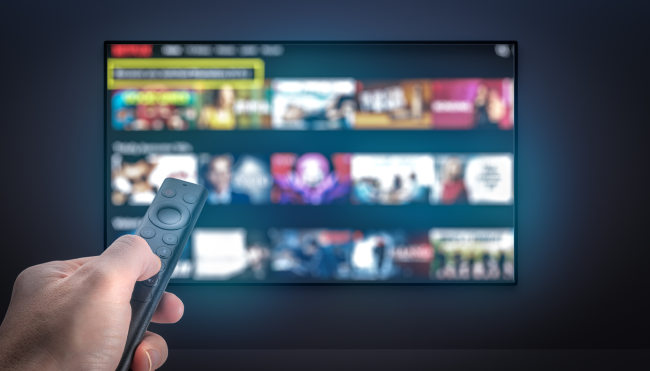- Why Amagi
-
Solutions
Contact UsBusinessWho We Serve
- Offerings
- AI
-
Resources
Contact UsINDUSTRY REPORTSAmagi FAST Report #15: The Power of Live Programming: A Catalyst for Streaming SuccessAugust 21, 2025Read More
-
Company
Contact UsNewsroomAmagi launches AI-powered Smart Scheduler to improve content programmingApril 3, 2025Read More
Blog
Combating 5 biggest challenges of SSAI with Amagi THUNDERSTORM
By Ankit Raj - December 9, 2022
Ad-supported streaming takes the cake
Ad-supported streaming TV has left Subscription Video On Demand (SVOD) services behind in adoption rates. This year, in the US alone, the former recorded a 29% increase in adoption rates compared to the latter's 21%.
There are a lot of factors contributing to this steady increase in ad-supported TV adoption rates. The primary reason, of course, is the Total Cost of Ownership (TCO) involved. Having multiple SVOD subscriptions means the users spend a lot more on entertainment, while ad-supported models bring them free content in exchange for watching a few ads. That makes the latter more attractive, doesn’t it?
Looking at this trend, it becomes indispensable for content providers and platforms to explore ad-supported streaming. However, it is not enough. To maximize content monetization, you need to go the extra mile and explore technologies that can help.
SSAI to the rescue
Server Side Ad Insertion, or SSAI, is a critical technology that can help ramp up your monetization game and create a good user experience for ad-supported content. Here, ads are directly stitched into the video stream on the server side. While other technologies are available for ad-stitching, such as Client Side Ad Insertion (CSAI), SSAI has more advantages. Here are a few:
- A cable-like viewing experience: Since ads are stitched seamlessly and directly on the server side, it mimics a cable-like viewing experience with high-quality video and graphics.
- Adequate protection from ad blocking: SSAI is more robust and helps garner more ad impressions since it makes ad blockers less effective.
Read more: SSAI: A deep dive into effective content monetization
Although SSAI is a clear differentiator in the ad-supported content business, it also comes with a few challenges. Fortunately, our cloud-powered SSAI solution, Amagi THUNDERSTORM, is fully capable of combating these. Let's take a closer look at five such key challenges and how we at Amagi handle them:
Problem: Inventory fill optimizationThe major challenge with server-side ad insertion is getting the timing right. If we insert the ad too early, many users could become inactive when the ad is served. Also, there may be new active users, leading to the underfilling/overfilling of inventory. Therefore, ad stitching needs to happen close to real-time with the knowledge of current active users.
Solution #1: Real-time tracking of active users
Amagi THUNDERSTORM maintains a snapshot of active users and fetches the ad at the time of ad break to optimize inventory fill.
Solution #2: Waterfall techniques
Here's what happens in programmatic advertising. Supply tags match the demand tags from ad networks, and ads are fetched accordingly. Further, we need a waterfall strategy for ad tags to enhance the inventory fill wherein specific priorities are assigned to supply ad tags. Additionally, if one supply ad tag does not receive enough demand to fill the inventory, we must prioritize the next ad tag.
Amagi ADS PLUS provides one such backfill strategy, wherein the remaining inventory that the customer's supply ad tags could not fill gets filled by a set of ad tags configured by Amagi. This is based on the demand dynamics in the ads network.
Solution #1: Ad frequency management
Amagi PLANNER & Amagi THUNDERSTORM integrate to provide content and ad scheduling management. This integration allows customers to run A/B tests with different ad frequencies to understand what works best for their users.
Solution #2: Unique ads in an ad-break
Amagi THUNDERSTORM does not repeat ads within an ad break. This effectively means repeated ads do not hamper the viewer’s viewing experience within each ad break, thus creating an authentic TV-viewing experience.
Solution #3: Transcoding
Ad transcoding is essential to serve ads that match the bitrate profiles of the content viewers are watching, offering a seamless viewing experience. Amagi THUNDERSTORM provides dynamic transcoding of ad profiles, reducing storage requirements and ensuring that playback seamlessly transitions between the ad and video content.
Solution #1: Personalization at scale
Maximizing ad opportunities without barraging audiences with irrelevant ads requires an intelligent technique that offers hyper-personalized ads. Ads that viewers can relate to lead to higher ad opportunities and impressions.
Amagi THUNDERSTORM uses PUP, or Per-User Playlist, which creates a personalized ad viewing experience at scale for the CTV audiences. Users see a different ad playlist based on their viewing preferences and other personalization metrics.
Solution #2: Ad session management
Preserving sessions for channel browsing using device ID is another solution. It helps monetize users even if they return to the original stream within a particular time. This use case is crucial for FAST (Free Ad-supported Streaming TV) viewer monetization, where channel hopping is ingrained user behavior and monetizing such customers requires ad session management mechanisms.
Problem: Ad request latency
Solution #1: Maintaining a hard timeout
In cases of ad requests to VAST-compliant servers, the SSAI engine must maintain a hard timeout duration. How does that help? A hard timeout eliminates the need to push the content schedule ahead because of too much time spent waiting for ads from servers.
Solution #2: Fallback to filler ads
In case of a hard timeout, SSAI must have a mechanism to fall back on filler ads without inducing much delay in programming. The more automated these systems and processes are, the easier it is to handle such exceptions.
Solution #1: Ad tracker
The tracker URL is also part of the VAST response whenever an SSAI platform receives an ad from the ad network. Amagi THUNDERSTORM ensures that once served to the users, the ads have various metrics associated with them that need to be monitored and optimized as a content owner/platform owner. The analytics need to be accurate as this can lead to insights like the user’s ad viewing experience and related behaviors like genres to ad mapping, channel hopping behavior, and geography-based targeted campaigns.
Are these challenges stopping you from making the most of your content? We can help.
Get the Amagi advantage. Reach out to us at cloudandme@amagi.com.
Related Blogs
Get started
Increase revenue and reach with our Broadcast & Streaming solutions.
Cloud modernization. Streaming unification. Monetization. Marketplace.
 German
German French
French Spanish
Spanish Korean
Korean Japanese
Japanese Portuguese
Portuguese


